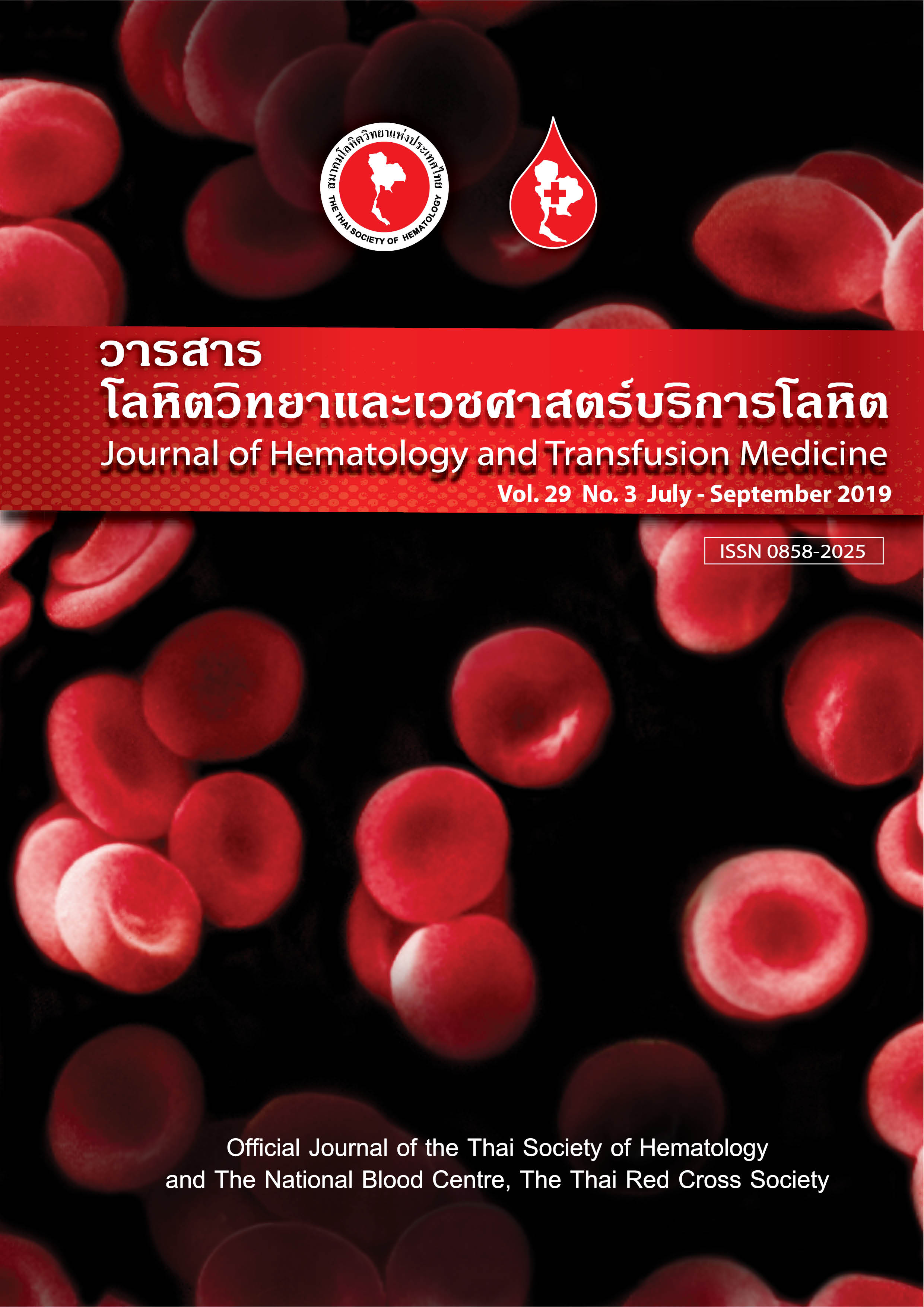HLA-A, -B, and -DR frequencies in deceased kidney donors of the Organ Donation Centre, Thai Red Cross Society
คำสำคัญ:
แอนติเจน HLA, ความถี่แอนติเจน HLA, ผู้บริจาคไตสมองตาย, HLA antigens, Frequency, Deceased kidney donorsบทคัดย่อ
บทคัดย่อ
ความเป็นมา ศูนย์รับบริจาคอวัยวะสภากาชาดไทย ร่วมกับศูนย์บริการโลหิตแห่งชาติ สภากาชาดไทยได้ดำเนินการตรวจแอนติเจน HLA-A, -B และ -DR ในผู้บริจาคไตสมองตายตั้งแต่ปี พ.ศ. 2540 จนถึงปัจจุบัน แต่ยังไม่มีฐานข้อมูลแอนติเจนดังกล่าวในผู้บริจาคไตสมองตาย วัตถุประสงค์ เพื่อรวบรวมข้อมูลทั่วไป และความถี่ของแอนติเจน HLA ในผู้บริจาคไต เพื่อใช้เป็นข้อมูลในการจัดสรรไตให้กับผู้ป่วยที่ขึ้นทะเบียนรอรับการปลูกถ่ายไต วัสดุและวิธีการ ศึกษาข้อมูลย้อนหลังของผู้บริจาคไตสมองตายศูนย์รับบริจาคอวัยวะสภากาชาดไทย ตั้งแต่วันที่ 21 ธันวาคม พ.ศ. 2539 ถึงวันที่ 31 ธันวาคม พ.ศ. 2561 ผลการศึกษา ผู้บริจาคไตที่ตรวจแอนติเจน HLA จำนวน 2,209 ราย มีอายุเฉลี่ย 36 ปี ช่วงอายุ 31-40 ปี (26.60%) พบมากที่สุด เพศชายมากกว่าเพศหญิง 4.7 เท่า ความถี่ของ HLA-A และ HLA-B ที่พบบ่อย สูงสุด 4 อันดับแรก คือ A11, A2, A24 และ A33 (29.29%, 28.07%, 18.56% และ 12.06%) และ B46, B13, B75 และ B18 (15.93%, 8.92%, 7.63% และ 6.63%) ตามลำดับ ส่วน HLA-DR ที่พบบ่อย คือ DR15, DR12, DR9 และ DR4 (23.38%, 15.91% , 10.91% และ 9.62%) ตามลำดับ เมื่อเปรียบเทียบความถี่ของ HLA-A, -B และ -DR ในกลุ่มผู้บริจาคไตกับอาสาสมัครเซลล์ต้นกำเนิดเม็ดโลหิตที่เคยรายงานไว้ ไม่แตกต่างกันอย่างมีนัยสำคัญทางสถิติ (p > 0.05) สรุป ความถี่ของแอนติเจน HLA ในผู้บริจาคไตสมองตายไม่แตกต่างจากกลุ่มประชากรไทยที่เคยรายงานไว้ นอกจากนี้ข้อมูลดังกล่าวสามารถประยุกต์ใช้เป็นฐานข้อมูลเพื่อพิจารณาการจัดสรรไตให้กับผู้ป่วยได้
Abstract:
Background: HLA-A, -B and -DR antigen testing has been performed in deceased kidney donors at the Organ Donation Centre and National Blood Centre, Thai Red Cross Society from 1997 until now. However, the database of HLA-A, -B and -DR antigens has not been collected so far. Objective: To collect demographic data and HLA-A, -B and -DR antigen frequencies in deceased kidney donors in order to implement in the kidney allocation system. Materials and Methods: In this retrospective study, 2,209 deceased kidney donors were included from December 21, 1996 to December 31, 2018. Results: Among 2,209 deceased kidney donors, their mean age was 36 years and the most common age group was 31-40 years (26.60%). The ratio between males and females was 4.7 : 1. The 4 most common HLA-A and HLA-B antigens were A11, A2, A24 and A33 (29.29%, 28.07%, 18.56% and 12.06%) and B46, B13, B75 and B18 (15.93%, 8.92%, 7.63% and6.63%), respectively. For HLA-DR, the 4 most common antigens were DR15, DR12, DR9 and DR4 (23.38%, 15.91%, 10.91% and 9.62%). When HLA-A, -B and -DR antigen frequencies were compared between deceased kidney donors and Thai Stem Cell Donor Registry, no significant difference was observed (p > 0.05). Conclusion: HLA antigen frequencies from this study showed no significant difference with previously reported in Thais. These relevant data will be applicable in the kidney allocation system.
Downloads
เอกสารอ้างอิง
2. O-Charoen R, Kupatawintu P, Sinsiri S, Salee S, Tatawatorn A, Nathalang O, et al. Preliminary results of selection criteria for cadaveric kidney transplantation by the Thai Red Cross. Transplant Proc. 2000;32:1574-5.
3. Cecka JM. The UNOS renal transplant registry. In Cecka JM, Terasaki PI, editors. Clin Transpl. Los Angeles: UCLA Immunogenetics Center; 2003. p. 1-20.
4. Kupatawintu P, Tatawatorn A, Phiencharoen S, Choketaweesak N, Nathalang O, Attajarusit Y, et al. Allocation criteria to increase chances of kidney transplantation for highly HLA-sensitized patients. J Hematol Transfus Med. 2014;24:103-9.
5. Eisenbrey III AB, Kopko PM. The HLA system. In: Fung MK, Eder AF, Spitalnik SL, Westhoff CM, editors. Technical manual. 19thed. Bethesda: AABB press; 2017. p. 435-54.
6. Kupatawintu P, Pheancharoen S, Srisuddee S, Tanaka H, Tadokoro K, Nathalang O. HLA-A, -B, -DR haplotype frequencies in the Thai Stem Cell Donor Registry. Tissue Antigens. 2010;75:730-6.
7. Chandanayingyong D1, Stephens HA, Klaythong R, Sirikong M, Udee S, Longta P, et al. HLA-A, -B, -DRB1, -DQA1, and -DQB1 polymorphism in Thais. Hum Immunol. 1997;53:174-82.
8. Romphruk A, Burusrux S, Puapairoj C, Urwijitaroon Y, Romphruk A, Leelayuwat C. Distribution of HLA-A and B antigens in northeastern-Thais. J Med Assoc Thai. 1996;79:732-6.
9. Fongsatikul L1, Nantachit N, Kamtorn N, Leetrakool N. HLA gene frequencies of northern Thais. J Med Assoc Thai. 1997;80:S38-42.
10. Tupmongkol T, Khanunthong S, Boonpokkrong P, Tatawatorn A, Nathalang O, Attajarusit Y, et al. Implementation of real-time PCR for HLA typing in deceased donors. J Hematol Transfus Med. 2017;27:217-24.
11. Burns JM, Cornell LD, Perry DK, Pollinger HS, Gloor JM, Kremers WK, et al. Alloantibody levels and acute humoral rejection early after positive crossmatch kidney transplantation. Am J Transplant. 2008;8:2684-94.
12. Gloor JM, Winters JL, Cornell LD, Fix LA, DeGoey SR, Knauer RM, et al. Baseline donor-specific antibody levels and outcomes in positive crossmatch kidney transplantation. Am J Transplant. 2010;10:582-9.
13. Thailand Road Safety Observatory. Traffic accidents statistics report. 2018 Dec [cited 2019 Jun 2019]:[about 1 p.]. Available from: https://trso.thairoads.org/statistic/national/N-SPI-A/N-SPI-A2/N-SPI-A2-01
14. Du KM, Ji Y, Xie JH, Fu M, Sun Y, Jin Y, et al. HLA-A, -B, -DR haplotype frequencies from DNA typing data of 26,266 Chinese bone marrow donors. Hum Immunol. 2007;68:854-66.
15. Yang KL, Lin PY. Determination of HLA-A, -B and -DRB1 haplotypes based on allelic homozygosity data in selected bone marrow donors of the Taiwanese marrow donor registry. Int J Immunogenet. 2007;34:385-92.
16. Tang TF, Hou L, Chen M, Belle I, Mack S, Lancaster A, et al. HLA haplotypes in Singapore: a study of mothers and their cord blood units. Hum Immunol. 2007;68:430-8.
17. Romphruk AV, Romphruk A, Kongmaroeng C, Klumkrathok K, Paupairoj C, Leelayuwat C. HLA class I and II alleles and haplotypes in ethnic Northeast Thais. Tissue Antigens. 2010;75:701-11.
18. Williams RC, Opelz G, McGarvey CJ, Weil EJ, Chakkera HA. The risk of transplant failure with HLA mismatch in first adult kidney allografts from deceased donors. Transplantation. 2016;100:1094-102.



